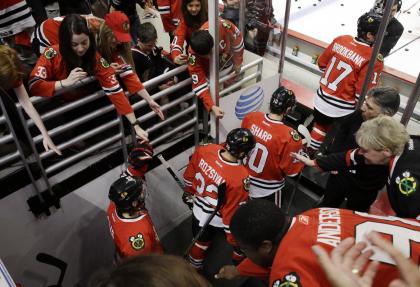Blackhawks arena sued again for fan injury; get ready for more safety netting

It’s difficult watching Chip Green talk about the injury he sustained at a Chicago Blackhawks’ playoff game against the Minnesota Wild last May.
A shot from Duncan Keith flew over the protective glass into the stands, striking Green on the side of his head. Since the incident, Green has trouble formulating words and claims he can no longer do mathematical equations. He no longer works to support his family of four.
On Thursday, his attorney Colin Dunn of Clifford Law Offices filed a lawsuit against the NHL and United Center seeking $200,000 in compensation and asking the team to extend its safety netting further around the rink.
Which they probably will, because this isn’t the only lawsuit they’re facing from a fan struck by a puck in the lower bowl.
Patricia Higgins file suit in July after being struck in the face by a puck in 2013, at Game 1 of the Stanley Cup Final. She was seated in row 11 of section 115, and claimed the safety netting wasn’t “functional” to protect her from the puck. She’s seeking $50,000 after suffering a bruised retina, a concussion and requiring reconstructive surgery.
[ Yahoo Sports Fantasy Hockey: It's time to join a league today! ]
The NHL mandated that every arena have safety netting after the death of 13-year-old Brittanie Cecil in 2002. She was seated in Section 121, Row S at Nationwide Arena when a puck struck her head. The nets are roughly 120 feet wide and 30 feet high. The NHL was actually behind the curve in adding them, as rinks in Europe and rinks in lower levels of North American hockey had them for years.
Will injuries like the ones in Chicago, and the lawsuits that follow, mandate further extension of the netting?
One assumes so, because lawsuits are usually catalysts for that sort of thing. But honestly, at what point do we ask these people if they knew what they were getting into? At what point does personal responsibility become the issue?
Again, our hearts go out to Green and his family, and to Higgins. But if you sit in the lower bowl, in the corners, you run the risk of getting a puck flying into your section at a high speed. This is not the case in sections at center ice on both sides, or behind the netting, or anywhere in the cheap seats. You’re sitting in the corner sections because your sight is unencumbered by the netting and because you can feel the velocity of the game in a way you can’t in the more isolated seats.
We went to the Jays game earlier this week in Toronto, and sat about eight rows back between third base and home plate. There’s no netting, no protection, just a pregame warning to “be aware”; and sure enough, someone a few sections over was drilled with a foul ball during the game.
They knew it could happen, being seated that close to the action, and that’s the real question here (although perhaps not the legal question): Is it contingent on the teams and arenas to predict the unpredictable and ensure nothing leaves the ice into the stands?
Or is there as assumed risk taken by spectators in order to feel like they’re “part of the action?”


